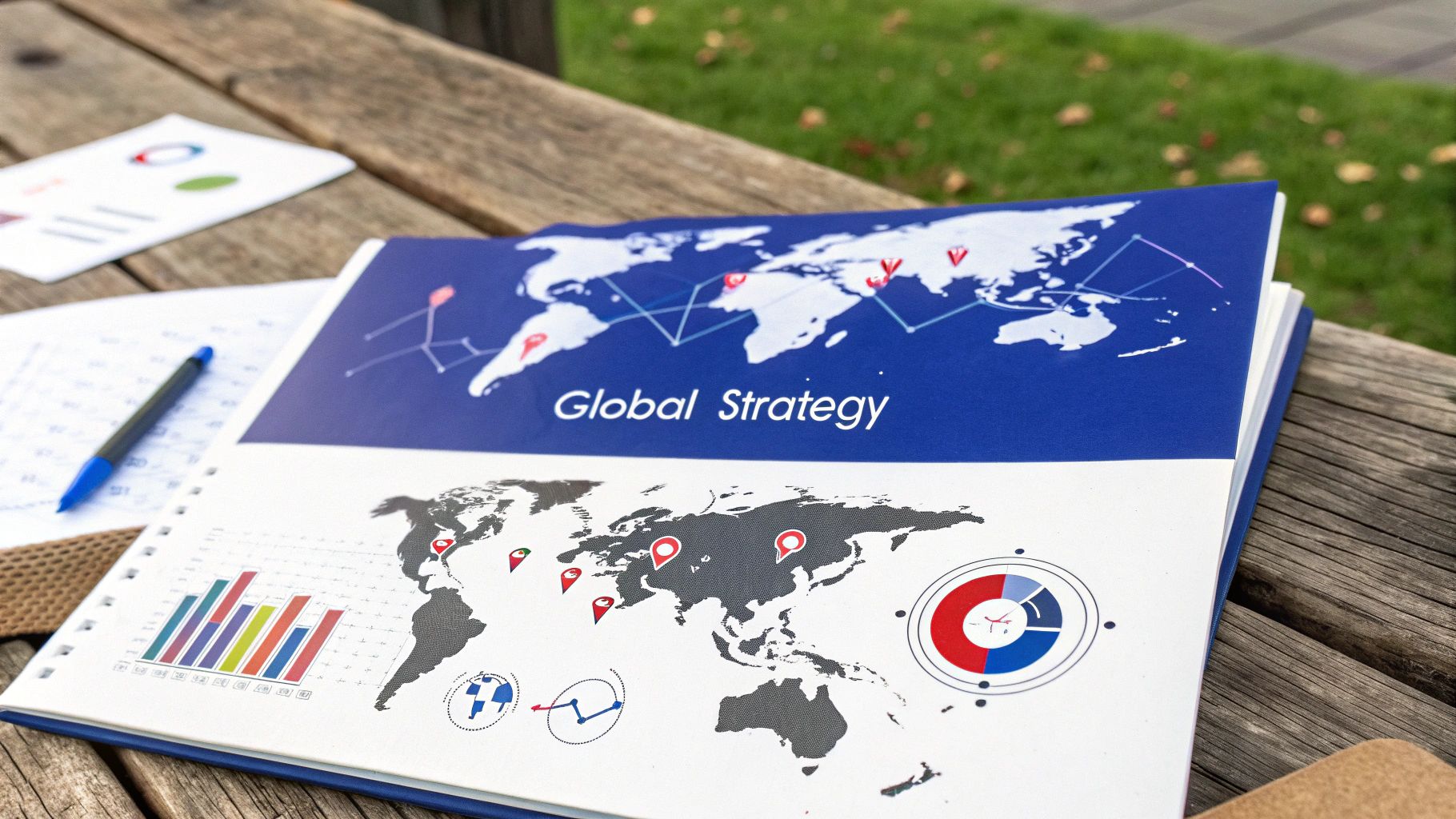Navigating South Africa’s International Wealth Management Landscape

South Africa is steadily gaining recognition in the international wealth management sector. Its solid financial systems and regulations are attracting high-net-worth individuals (HNWIs) worldwide. This growing sector offers diverse investment avenues, both within Africa and globally. Understanding this landscape is essential for effective wealth management and growth.
Understanding the South African Market
South Africa holds a unique position as a financial centre in Africa, offering distinct advantages for international wealth management. The country’s well-established banking system, advanced stock exchange (JSE), and expanding private equity market create attractive investment opportunities. The JSE, for example, provides access to a broad range of listed companies across various sectors.
South Africa’s regulatory environment, though evolving, aims to create a secure and transparent investment framework. This stability is crucial for HNWIs seeking long-term financial security. However, navigating these regulations can be challenging, emphasising the need for expert guidance. For further information, consider exploring resources on managing international wealth complexities: How to master international wealth complexities.
Growth and Potential of the Sector
The South African wealth management sector has experienced substantial growth. Total private wealth reached approximately $722 billion, with HNWIs holding about $306 billion. The number of HNWIs increased by 8%, reaching 43,600.
To better understand the market, let’s look at the following table:
South African Wealth Management Market Overview
A breakdown of key metrics in South Africa’s wealth management sector
| Metric | Value | Growth Projection (to 2027) |
|---|---|---|
| Total Private Wealth | $722 Billion | |
| HNWI Wealth | $306 Billion | |
| Number of HNWIs | 43,600 | +28% (to ~56,000) |
This table highlights the substantial wealth within South Africa and the projected growth in the number of HNWIs. This upward trend indicates South Africa’s increasing attractiveness for international wealth management. For more detailed statistics, see South Africa Wealth Management.
Key Considerations for International Investors
Several crucial factors warrant consideration when navigating South Africa’s international wealth management landscape:
- Currency Fluctuations: The volatility of the South African Rand necessitates careful currency management strategies for international investors.
- Tax Implications: Understanding South African tax laws and double taxation agreements is vital for optimising investment returns.
- Political and Economic Landscape: Staying informed about the political and economic climate is essential for making well-informed investment decisions.
- Local Expertise: Partnering with experienced wealth managers with local expertise is crucial for successfully navigating the market.
These considerations underscore the complex and dynamic nature of international wealth management in South Africa. Understanding these intricacies and seeking expert advice can help investors capitalise on the market’s potential.
The Client Shift: Traditional Banks vs. Boutique Wealth Firms

A noticeable shift is happening in the South African international wealth management landscape. Clients are moving away from large, traditional banks and toward smaller, boutique wealth firms. This trend reflects a growing desire for personalised service and customised investment strategies.
Clients often find boutique firms better suited to their unique needs, particularly when seeking expert advice on offshore trusts or international tax complexities. This change highlights a shift in how South Africans perceive and approach wealth management.
South Africa’s wealth management sector holds just over $85 billion in assets under management (AUM), securing its position as the largest wealth management hub in Africa. Boutique firms are gaining traction within this evolving market, challenging traditional banking giants like Investec, RMB, and Nedbank. For a deeper dive into these industry statistics, check out this resource: South Africa’s Wealth Management Industry. Despite this shift, traditional banks continue to play a significant role and offer valuable services for specific client demographics.
Traditional Banks: Strengths and Limitations
Traditional banks offer a comprehensive suite of financial services, including international wealth management. Their significant resources, global presence, and long-standing reputation provide clients with a sense of stability and security. Clients can access a variety of services under one roof, ranging from everyday banking to complex investment options.
Moreover, these institutions typically boast well-established infrastructure and robust compliance departments, creating a secure environment for asset management.
Boutique Wealth Firms: A Personalized Approach
Boutique firms, in contrast, specialise exclusively in wealth management. Their smaller scale allows for a higher degree of personalisation and fosters closer client relationships. A boutique firm might specialise in a niche area, such as managing the assets of families involved in agriculture, tailoring investment strategies to their specific circumstances, and leveraging industry expertise.
This dedicated approach results in a more customised investment strategy and a higher level of personal attention.
To better illustrate the key differences, let’s examine a comparison table:
Traditional vs. Boutique Wealth Management Comparison
Comparing service offerings, fee structures, and client experience between traditional and boutique firms
| Feature | Traditional Banks | Boutique Firms | Client Benefit |
|---|---|---|---|
| Service Scope | Broad range of financial services | Specialised wealth management | Clients can choose a firm that aligns with their specific needs. |
| Client Relationships | Generally less personalised | Highly personalised, closer relationships | Boutique firms offer a more tailored and attentive experience. |
| Investment Strategies | Often standardised | Customised to individual needs | Clients benefit from bespoke solutions designed for their unique goals. |
| Resources & Infrastructure | Extensive resources and global reach | More focused resources | Clients of traditional banks benefit from broader access, while boutique clients receive specialised expertise. |
| Fee Structures | Can be higher due to overhead | Potentially more competitive | Fee structures vary, and clients should compare options carefully. |
Choosing the right wealth management partner depends on individual circumstances and priorities. Boutique firms shine in providing tailored advice and building close relationships, while traditional banks offer stability and a comprehensive suite of services.
Choosing the Right Fit: Factors to Consider
Selecting the appropriate partner for wealth management depends on your individual needs and priorities. Consider factors like investment goals, risk tolerance, desired level of personalisation, and, of course, fee structures. Our Private Wealth Management guide provides a more comprehensive overview. The right fit for one person might not suit another.
For more insights into managing international wealth, see How to Master International Wealth Complexities. Understanding the nuances of each model allows you to make informed decisions.
Evolving Landscape: Adapting to Client Needs
Both traditional banks and boutique firms are evolving to meet the changing market demands. Banks are increasingly integrating personalised services and digital tools, while boutiques are expanding their expertise and global reach. This evolution demonstrates a growing awareness that clients value personalised attention alongside advanced financial solutions. This ongoing adaptation will continue to shape the future of international wealth management in South Africa.
Winning Investment Strategies for African High-Net-Worth Clients

Effective wealth management for high-net-worth individuals (HNWIs) in Africa requires a strategic approach. This considers both local market conditions and global opportunities, moving beyond basic portfolio management. It involves understanding the intricacies of international wealth management to achieve exceptional results, especially in South Africa’s unique financial landscape.
Balancing Domestic and International Investments
Finding the right balance between domestic and international investments is key for African HNWIs. Local markets, especially sectors like renewable energy and technology, offer significant growth potential.
However, offshore investments are crucial for diversifying against local economic volatility and currency fluctuations. This mitigates risk and enhances overall portfolio stability. Allocating assets to developed markets, for example, can provide stability during uncertain times in emerging markets, acting as a safety net to preserve capital.
Managing Currency Exposure and Maximizing Returns
Currency exposure is a major factor for African investors. Fluctuations in the South African Rand, for example, can significantly impact returns. Skilled wealth managers use strategies like currency hedging to mitigate these risks.
The process involves using financial instruments to lock in exchange rates and protect against adverse currency movements. They also actively seek opportunities to capitalise on favourable currency shifts to improve returns, ensuring fluctuations don’t erode gains.
Exploring Alternative Investments
Beyond traditional stocks and bonds, alternative investments are growing in importance for HNWIs. These include private equity, real estate, commodities, and hedge funds.
While potentially offering higher returns and diversification, they also carry higher risks. Carefully chosen alternatives can complement traditional holdings and provide access to specialised markets. Investing in African infrastructure projects or agricultural ventures, for instance, can offer unique growth opportunities while contributing to local development. This allows investors to participate in specific growth areas while diversifying. You might be interested in: How to master high-net-worth wealth management.
Integrating ESG Considerations
Environmental, social, and governance (ESG) factors are increasingly important in investment decisions. Many HNWIs seek investments aligned with their values and contributing to a sustainable future. This involves incorporating ESG criteria into investment analysis and portfolio construction.
Investors might focus on companies with strong environmental records or those promoting social equity. This approach supports positive-impact businesses while potentially achieving long-term financial goals, reflecting a growing awareness of the link between financial performance and societal well-being.
Sector-Specific Opportunities in Africa
Africa offers numerous sector-specific opportunities for HNWIs. The continent’s resources, expanding consumer base, and growing technology adoption create compelling prospects. Resources, technology, and agriculture are particularly attractive sectors.
For example, growing demand for minerals and metals presents opportunities in the mining sector. The swift growth of mobile technology creates opportunities in the fields of telecommunications and fintech. Advancements in agricultural practices and rising food demand make agribusiness promising. These opportunities offer the potential for high growth and diversification within Africa, allowing investors to capitalise on the continent’s unique growth drivers.
Tax-Efficient Structures in International Wealth Management

In international wealth management, a truly effective strategy hinges on its tax efficiency. This is especially important in South Africa, where tax laws are always changing. Understanding and using tax-efficient structures is key to protecting and growing your wealth across different countries.
Minimizing Tax Drag on Investments
Tax drag is the reduction of your investment returns because of taxes. Smart advisors use several strategies to minimise this.
- Holding assets in tax-advantaged accounts like retirement annuities. These offer tax deductions on contributions and tax-free growth.
- Using tax-loss harvesting. This offsets capital gains with capital losses, lowering your overall tax burden.
These methods aim to retain a larger portion of your investment gains.
Leveraging Double Taxation Agreements
South Africa has double taxation agreements (DTAs) with many countries. DTAs prevent you from being taxed twice on the same income in two different places.
For example, a DTA can lower or even eliminate the South African tax on investment income you earn from the UK if the UK has already taxed it and you live in South Africa. Understanding these agreements is crucial for maximising your international investment returns.
Compliant Offshore Arrangements for Asset Protection
Offshore structures can be a powerful way to protect your assets. But these arrangements must follow all South African and international rules.
Experienced advisors can help you set up structures like offshore trusts or companies that meet these requirements. This protects your assets while ensuring you comply with all laws.
Navigating Global Information Sharing Standards
International information-sharing programmes like the Common Reporting Standard (CRS) have changed how we approach tax planning. The CRS requires financial institutions to share information about foreign account holders with tax authorities.
This transparency means hiding offshore accounts to avoid taxes is no longer a viable option. Wealth managers are adapting by focusing on legal and transparent international tax strategies. It’s now more important than ever to work with advisors who understand complex international tax rules.
Estate Duty Optimization and Exchange Control Considerations
Estate duty, a tax on the transfer of wealth after death, can significantly reduce an estate’s value. Good estate planning includes strategies to minimise this, like gifting assets during your lifetime or using trusts.
South Africa also has exchange control regulations that limit how money moves in and out of the country. Understanding these regulations is vital for managing international wealth, especially for South African residents investing abroad. Knowing about both estate duty and exchange controls is essential for effective long-term wealth preservation.
Tax-Efficient Vehicles for International Business
For those with international businesses, structuring them in a tax-efficient way is essential. The process could involve setting up companies in countries with favourable tax rules or using specific investment vehicles.
However, it’s critical to ensure these structures are both tax-efficient and compliant with South African regulations. Balancing optimisation and compliance requires careful planning and expert advice.
International wealth management is complex. By focusing on tax-efficient structures and following changing regulations, you can better protect and grow your wealth. This involves seeking advice from experts in South African and international tax law, as well as understanding estate planning and exchange controls. These elements are crucial for a robust and effective international wealth management strategy.
Digital Revolution in International Wealth Management
Technology is rapidly changing the landscape of international wealth management, bringing increased accessibility and transparency. This evolution significantly impacts how South African firms engage with their clients and manage their assets. Let’s delve into these key developments.
AI-Driven Analytics and Personalized Strategies
Artificial intelligence (AI) is emerging as a powerful tool in wealth management. Artificial intelligence-powered analytics processes massive datasets to create individualised investment strategies.
AI can analyse a client’s risk tolerance, financial objectives, and market conditions to recommend the best asset allocation. This personalised approach empowers wealth managers to offer bespoke advice and potentially enhance investment performance.
This technology helps move beyond standard portfolio models, providing clients with strategies designed for their specific circumstances. The result is more effective and focused investment plans, ensuring alignment with each client’s unique situation.
Blockchain Applications for Enhanced Security and Efficiency
Blockchain technology, known for its robust security and transparency, is finding its place in international wealth management. It can bolster the security of transactions and streamline processes through automation.
This translates to lower transaction costs and faster processing times. Blockchain also strengthens record-keeping, simplifying the tracking and verification of transactions. This helps ensure data integrity and mitigate the risk of fraud, fostering client trust and confidence.
Digital Platforms and Client Empowerment
Digital platforms are transforming how clients interact with their wealth. These platforms provide real-time portfolio access, enabling clients to monitor performance, view reports, and communicate directly with their advisors.
This enhanced visibility empowers clients to take a more active role in managing their finances. Open access to information and direct communication cultivate a stronger client-advisor relationship, facilitating informed financial decisions.
Balancing Technology with Human Expertise
While technology plays a crucial role in modern wealth management, human expertise remains indispensable. Complex financial situations often require the nuanced understanding and judgement that only a seasoned advisor can offer.
This is especially pertinent in international wealth management, where navigating intricate tax laws and regulations across various jurisdictions is paramount. The most effective approach combines the convenience of technology with the irreplaceable value of human insight. By integrating powerful data analysis with personalised guidance, wealth managers can deliver superior service. Ultimately, understanding a client’s personal goals and circumstances remains the cornerstone of effective wealth management. This approach builds trust, facilitates personalised strategies, and expertly navigates complexities. Clients benefit from both advanced technology and tailored advice.
Beyond Wealth: Legacy Planning Across Generations
True international wealth management goes beyond immediate investment returns. It involves the careful transfer of assets, values, and purpose across generations. This is especially important in South Africa, where family businesses and inherited wealth play significant roles. Let’s explore how South African wealth managers guide families through the complexities of succession planning.
Navigating Family Dynamics and Conversations
Openly communicating about inheritance within families can be difficult. Wealth managers act as facilitators, helping families navigate these sensitive discussions. They create a safe environment for family members to express their concerns, aspirations, and expectations regarding wealth transfer.
For example, they might help a family define clear expectations about the roles of family members in managing inherited businesses. This ensures everyone understands their responsibilities and reduces potential conflicts, leading to a smoother transition.
Governance Structures for Family Harmony
Creating effective governance structures is essential for maintaining family unity during inheritance. Wealth managers help establish family constitutions or trusts, outlining how assets will be managed and distributed.
These frameworks provide clarity and accountability, offering a structured process for making decisions about family assets. This can prevent disputes and preserve family harmony.
Balancing Traditional Values with Modern Realities
South African families often hold strong traditions that influence their views on wealth and inheritance. Wealth managers understand these nuances and create flexible frameworks that respect these values while adapting to modern needs.
They help families balance the desire to uphold traditions with the practicalities of managing wealth in a globalised world. For instance, they might work with families to create structures that support philanthropic activities aligned with their values while also ensuring the family’s long-term financial security.
Preparing the Next Generation for Wealth Responsibility
Preparing future generations to manage significant wealth requires careful planning. Wealth managers develop educational programmes, mentoring opportunities, and practical experiences to equip heirs with the skills to handle their inheritance responsibly.
This might involve introducing younger family members to financial concepts, investment strategies, and philanthropic activities. This empowers the next generation to make sound financial decisions and continue the family’s legacy of wealth management. The rapid advancement of technology is changing wealth management. Learn more about the impact of AI in wealth management.
Establishing Meaningful Philanthropic Legacies
Many families want to use their wealth to benefit society. Wealth managers help establish philanthropic foundations or structured giving programmes. These initiatives align with the family’s values and make a lasting impact on the causes they support.
They help structure donations for maximum tax efficiency and collaborate with families to choose organisations and projects that match their philanthropic vision. This process creates a sense of purpose that extends beyond financial wealth.
Tax-Efficient Transfers within South Africa’s Legal Framework
Navigating South Africa’s legal and tax environment is vital for efficient wealth transfer. Wealth managers work with legal experts to implement tax-optimised strategies for estate planning.
They consider factors like estate duty, capital gains tax, and donations tax, structuring asset transfers to minimise tax liabilities. They also advise on using trusts and other legal structures to protect assets and facilitate smooth intergenerational transfers. This ensures wealth is preserved and passed on efficiently while complying with all legal requirements. They also stay up-to-date on changes in South African tax law, adapting strategies to maintain tax efficiency.
Protecting International Assets
For families with international assets, wealth managers provide expert guidance on cross-border wealth structuring and tax compliance. They navigate international tax treaties and regulatory frameworks, ensuring assets are protected and regulations are followed.
They help families understand the tax implications of holding assets in different jurisdictions and advise on strategies to minimise potential tax liabilities. This approach to international wealth management ensures that the family’s global wealth is managed effectively and legally.
Are you ready to secure your family’s financial future and build a lasting legacy? Contact Expat Wealth At Work today. We provide specialised international wealth management solutions designed for your family’s unique needs. Visit us at https://expatwealthatwork.com to learn more.













![The Real Price of Positive Financial Market Returns [Expert Guide]](https://expatwealthatwork.com/wp-content/uploads/2025/03/The-Real-Price-of-Positive-Financial-Market-Returns-Expert-Guide.png)





 Image Source:
Image Source: 


